Catherine Wen's Gallery
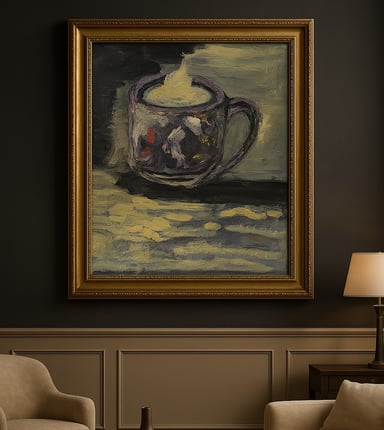

Title: “The Season Forgets Itself”
Acrylic on canvas. 2025.
It was late March, but the sky was gray and cool, and everything felt like early October. So I made coffee. Then I made this.
The Season Forgets Itself began as layers of messy abstraction—color laid down in quiet rebellion. Yellow, gray, black. Some red. I didn’t know what it would become. I just knew I needed to pour something out.
Later, after a visit to a library cafe and an impromptu pumpkin spice latte, I returned to the canvas. Using negative painting, I pulled the shape of a coffee cup from the storm of color, revealing a secret that had been hiding in plain sight. The cup appeared imperfect, spectral. Familiar. My favorite part? The soft spiral of whipped cream on top, almost glowing.
This piece was made for someone who knows the beauty of in-between seasons. Who loves the taste of nostalgia out of sync. Who finds magic in mess, and ritual in repetition. If you feel held by this painting— write to the curator. But remember: the season may shift again before you do.
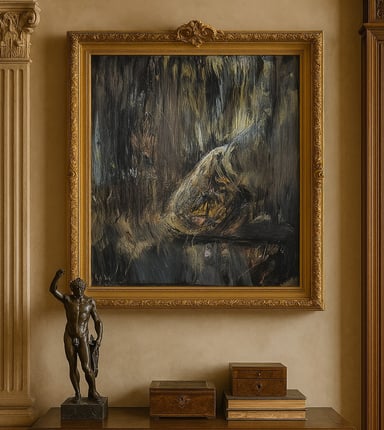

Title: “The Oracle's Fruit”
Acrylic on canvas. 2025.
This painting began as a meditation on light.
But, like all oracles, it had other plans.
What was once an abstract exploration evolved—unexpectedly, intuitively—into a solitary pear resting in a forest clearing. But the pear is not merely a fruit. It is a vessel. A keyhole. A quiet rupture in the veil.
The Oracle’s Fruit was painted in layers, the brush guided less by intention than by surrender. What emerged was not planned. And yet it feels inevitable. Within the pear is a suggestion of another realm—something blooming, or burning, or waiting.
This is a painting for someone who believes that the mundane can be mystical. That a pear might be a world. That light has a mind of its own.
If this piece holds your gaze longer than you expected…
write to the curator. But know this:
You are not just looking at it.
It’s looking back.
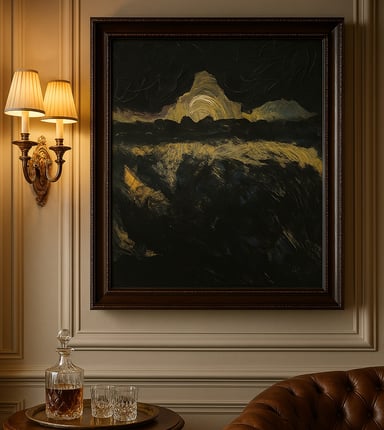

Title: “The Light Remembers”
Acrylic on canvas. 2025.
This is not a place.
It’s a feeling that became terrain.
The Light Remembers began in deliberate chaos—layer after layer of shifting color and movement. The landscape itself was never painted directly. It was revealed through the practice of negative painting: removing, darkening, isolating—until the form emerged like something remembered, not imagined.
The result is an abstracted landscape suspended between dusk and revelation. The golden light doesn’t dominate. It haunts. It bleeds through darkness like a secret refusing to be buried.
This is a painting for someone who understands that illumination is not always gentle. That the past lingers in layers. That beauty often appears only after we’ve scraped something away.
If this piece reflects you—if it reminds you of somewhere you've never been—
write to the curator.
But remember: the light remembers everything.
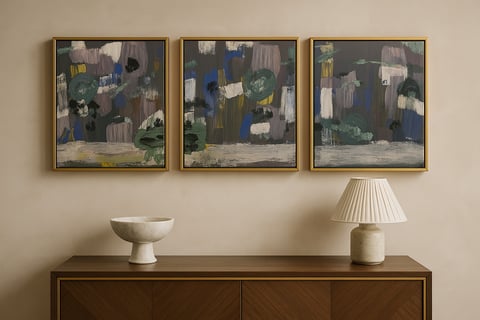

Title: “The Dream Eats Itself”
Triptych. Acrylic on canvas. 11"x14" each. Painted March 27, 2025.
This is a triptych for those who know the shape of chaos when it smiles.
Created in two furious sessions—three canvases breathing as one—The Dream Eats Itself emerged from a place of freedom. The artist moved with large brushes and no allegiance to outcome. The forms arrived before their meaning. The contrast came later, like rain stitching clarity into fog.
The dominant color is a bruised, royal violet—mysterious, unresolved. Green becomes the focal anchor: ancient, soft, ever-returning. Blue whispers along the edges like memory, while yellow sparks mischief into the quiet. Frame-within-a-frame compositions tease the viewer, offering nested interpretations, like windows looking into other windows.
Inspired by the teachings of Robert Burridge, but unbound by them, this work was conjured in motion. It is not about precision. It is about permission. The kind of permission few people ever grant themselves.
If you see yourself in these three panels—if they speak to something shapeless yet known within you—you may write a letter to the curator.
But know this: the dream is already eating itself.
And it does not promise to wait.
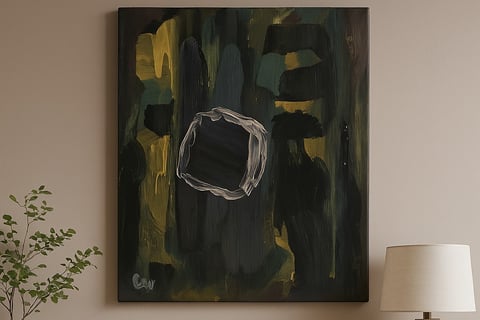

Title: “They Were Never Here”
Acrylic on canvas. 11"x14". Painted in fragments, 2025.
The woman and the man were once walking here. But they’ve vanished.
All that remains is suggestion, shadow, and the trace of a mistake turned spell.
They Were Never Here began with a spill—a burst of yellow across the studio table. The kind of accident that demands surrender. Instead of cleaning it up, the artist followed it. What emerged is a vertical composition layered in secrecy: rich greens, midnight blacks, soft ochres, and something underneath that resists full burial.
This painting was created in short bursts—mere seconds at a time. A session of movement, then pause. Stillness, then blur. Sometimes the paint was allowed to dry. Sometimes it wasn’t. The result is a quiet contradiction: texture and translucency. Pressure and pullback. Concealment and confession.
The white-lined shape at the center is not a wound, not quite a portal. It might be a scar. It might be a whisper.
This work is for someone who understands that what has been painted over is never truly gone. Someone who can feel presence inside absence. Someone who wants to be haunted—just a little.
You may not ask for it. And it may choose to remain unclaimed.
Connection
Fine art that finds its true home; possibly with you.
© 2025. All rights reserved.
